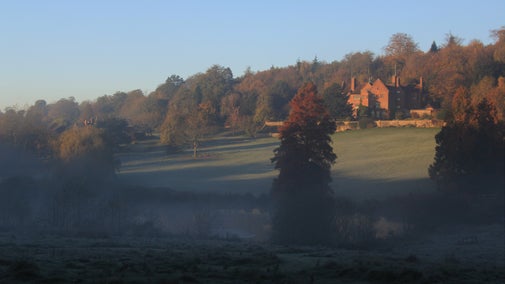
Discover more at Chartwell
Find out when Chartwell is open, how to get here, the things to see and do and more.

The fruit and vegetable beds sit within the Walled Garden at Chartwell and the whole area is a constant hive of activity. From spring, all the way through to winter, there's always something new growing, or being planted ready for next year.
Spring is a very busy time of the year for the edible areas of the Walled Garden. Many of the seeds are sown in the greenhouses, including pumpkins that are a great feature around Halloween. The greenhouses are quickly packed full of trays containing seeds, soon bursting into life.
Out in the garden, with the beds now empty after winter, construction work takes place. Some of the crops require protection from pests, and cabbages are netted in order to protect them from being eaten by cabbage white butterflies and birds.
As spring draws to a close, the young plants are taken out of the greenhouse and hardened off in the cold frames, ready for being planted in their final position out in the garden.

With most of the crops now planted out in the ground and steadily becoming established, watering becomes important during these drier, warmer months. The water supply in the Walled Garden is supplied with water from the lake. This works by using a clever system of pumps that enable a large water tank to be filled to store water and supply all the taps in the Walled Garden and greenhouses, yet also allowing water to be pumped around the ponds and cascades in the garden.
Many hours are spent weeding so the weeds don’t compete with the crops for water, nutrients and light. Deadheading is also carried out and annual crops harvested to ensure that the produce continues to flower and set fruit.
Wall trained fruit are also pruned in summer so that the plant doesn’t respond with vigorous re-growth, as it would if pruned during winter.

At this point of the year, we harvest many of our crops and begin to clear the beds of plants that have finished cropping such as the beans, and pumpkins. Crops that can survive the winter are planted out, including broad beans, lettuce, spinach and spring onions.
The apples from the orchard are harvested and taken to a local farm, where they are pressed to produce apple juice.
Summer fruiting raspberries are pruned, with this year’s fruited canes cut back to ground level. The new growths from this season are tied into the supports, ready to bear next year’s fruit.
Winter is the ideal time to prune the fruit bushes and trees, as without their leaves, the framework of the tree or bush can easily be seen. Autumn fruiting raspberries have their canes pruned to the base because these will fruit on new canes over the next season. Blackcurrants, red currants and gooseberries are then pruned to keep them healthy and productive.
This is also the time of year to prune apple and pear trees. The trees in the orchard have any dead, diseased or damaged wood removed, and each tree is assessed to ensure they have an open framework of branches. This is to enable adequate air circulation, preventing disease and allowing maximum light to reach the leaves and fruit.
It’s a fine balance retaining as many of the fruiting branches as possible to maximise fruit yields, whilst maintaining an open and healthy tree. Removing too much of the framework of branches will lead to the tree producing new shoots rather than fruit.
As winter draws to a close, we clear all the beds and dig over the soil, applying a base dressing of organic matter, usually manure. This provides some nutrients, but more importantly opens the soil to improve its structure.

Find out when Chartwell is open, how to get here, the things to see and do and more.
Enjoy the views that the Churchills chose Chartwell for, and explore the garden they created and loved, from Lady Churchill’s Rose Garden, to the Walled Garden Sir Winston helped build.

Chartwell’s estate and surrounding countryside offers far-reaching views across the Weald. Walk in the footsteps of one of our founders Octavia Hill when you explore Mariners Hill.

Chartwell is a three pawprint rated place. Bring your four-legged friend along on a short lead for a stroll around the garden or go for a roam in the woods. Find out more about where you can and can't take your dog.
